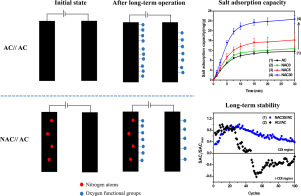当前位置:
X-MOL 学术
›
Desalination
›
论文详情
Our official English website, www.x-mol.net, welcomes your feedback! (Note: you will need to create a separate account there.)
Improved performance and long-term stability of activated carbon doped with nitrogen for capacitive deionization
Desalination ( IF 9.9 ) Pub Date : 2020-05-01 , DOI: 10.1016/j.desal.2020.114362 Chun-Chia Hsu , Yi-Heng Tu , Yu-Hsiang Yang , Jeng-An Wang , Chi-Chang Hu
Desalination ( IF 9.9 ) Pub Date : 2020-05-01 , DOI: 10.1016/j.desal.2020.114362 Chun-Chia Hsu , Yi-Heng Tu , Yu-Hsiang Yang , Jeng-An Wang , Chi-Chang Hu

|
Abstract Nitrogen-doped activated carbon (NAC) is prepared by a combination of acid pre-treatment and thermal nitrogen doping for the positive electrode of asymmetric capacitive deionization (a-CDI) cells. The oxygen content in AC controlled by the acid pre-treatment significantly affects the doping amount of N atoms from melamine, which enhances the surface negative charge in NACs to promote the salt adsorption capacity (SAC). Here NAC with 30% HNO3 pre-treatment (NAC30) possesses a highly negatively charged surface to exhibit a fast ion desorption rate during discharging. The asymmetrical NAC30//AC cell shows the maximum reversible SAC of 24.7 ± 1.6 mg g−1. In addition, the negative surface charge of NAC30 is further promoted and the reversible SAC of NAC30//AC are greatly enhanced to ca. 55 mg g−1 when pH of the 8 mM NaCl solution is adjusted from 5.4 to 7.5. In the long-term stability test, NAC30//AC remains 40% of its maximum reversible SAC after 100 charging-discharging cycles, indicating that our nitrogen doping is able to effectively reduce the oxidation of activated carbon, confirmed by the electrochemical impedance analysis.
中文翻译:

用于电容去离子的掺氮活性炭的改进性能和长期稳定性
摘要 掺氮活性炭(NAC)是通过酸预处理和热氮掺杂相结合的方法制备的,用于非对称电容去离子(a-CDI)电池的正极。酸预处理控制的活性炭中的氧含量显着影响三聚氰胺中 N 原子的掺杂量,这增强了 NAC 中的表面负电荷以促进盐吸附能力(SAC)。此处采用 30% HNO3 预处理的 NAC (NAC30) 具有高度带负电荷的表面,在放电过程中表现出快速的离子解吸速率。不对称 NAC30//AC 电池的最大可逆 SAC 为 24.7 ± 1.6 mg g-1。此外,进一步促进了 NAC30 的表面负电荷,NAC30//AC 的可逆 SAC 大大增强至约。当 8 mM NaCl 溶液的 pH 值从 5.4 调整到 7.5 时,为 55 mg g-1。在长期稳定性测试中,NAC30//AC在100次充放电循环后仍保持其最大可逆SAC的40%,表明我们的氮掺杂能够有效减少活性炭的氧化,电化学阻抗分析证实。
更新日期:2020-05-01
中文翻译:

用于电容去离子的掺氮活性炭的改进性能和长期稳定性
摘要 掺氮活性炭(NAC)是通过酸预处理和热氮掺杂相结合的方法制备的,用于非对称电容去离子(a-CDI)电池的正极。酸预处理控制的活性炭中的氧含量显着影响三聚氰胺中 N 原子的掺杂量,这增强了 NAC 中的表面负电荷以促进盐吸附能力(SAC)。此处采用 30% HNO3 预处理的 NAC (NAC30) 具有高度带负电荷的表面,在放电过程中表现出快速的离子解吸速率。不对称 NAC30//AC 电池的最大可逆 SAC 为 24.7 ± 1.6 mg g-1。此外,进一步促进了 NAC30 的表面负电荷,NAC30//AC 的可逆 SAC 大大增强至约。当 8 mM NaCl 溶液的 pH 值从 5.4 调整到 7.5 时,为 55 mg g-1。在长期稳定性测试中,NAC30//AC在100次充放电循环后仍保持其最大可逆SAC的40%,表明我们的氮掺杂能够有效减少活性炭的氧化,电化学阻抗分析证实。



























 京公网安备 11010802027423号
京公网安备 11010802027423号